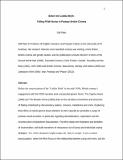Files in this item
Before the Colditz myth : telling POW stories in postwar British cinema
Item metadata
| dc.contributor.author | Plain, Gill | |
| dc.date.accessioned | 2016-07-31T23:30:57Z | |
| dc.date.available | 2016-07-31T23:30:57Z | |
| dc.date.issued | 2014-08 | |
| dc.identifier | 126195996 | |
| dc.identifier | a5bbe481-fdcb-4fb1-bd88-c1cbc45cd924 | |
| dc.identifier | 84904460658 | |
| dc.identifier.citation | Plain , G 2014 , ' Before the Colditz myth : telling POW stories in postwar British cinema ' , Journal of War & Culture Studies , vol. 7 , no. 3 , pp. 269-282 . https://doi.org/10.1179/1752627214Z.00000000048 | en |
| dc.identifier.issn | 1752-6272 | |
| dc.identifier.other | ORCID: /0000-0002-3387-4850/work/61622311 | |
| dc.identifier.uri | https://hdl.handle.net/10023/9232 | |
| dc.description.abstract | Before the concretization of the ‘Colditz Myth’ in the mid-1950s, British cinema's engagement with the prisoner of war (POW) narrative took unexpected generic forms. The Captive Heart (1946) and The Wooden Horse (1950) draw on the narrative conventions and structures of feeling mobilized by documentary realism, romance, melodrama, and crime. Exploring these films as hybrid genres draws attention to their capacity to symbolize a range of postwar social anxieties, in particular regarding demobilization, repatriation, and the reconstruction of peacetime masculinities. The films depict the frustration and boredom of incarceration, and build narratives of reassurance out of group and individual coping strategies. Yet, while characters might escape, the ‘duty to escape’ is not a central preoccupation: rather the films focus on the relationship between camp and home, and the reconstruction of the incarcerated male subject. Between 1946 and 1955, cinema variously imagines the prisoner of war camp as a space of holistic reconstruction, and as a site for the reconstruction of male agency through productive labour. These films, then, bear little resemblance to the war genre through which they are usually conceptualized: rather they draw on domestic tropes to examine the pressures confronting the male subject in the aftermath of war. | |
| dc.format.extent | 14 | |
| dc.format.extent | 280121 | |
| dc.language.iso | eng | |
| dc.relation.ispartof | Journal of War & Culture Studies | en |
| dc.subject | British cinema | en |
| dc.subject | Masculinity | en |
| dc.subject | Genre | en |
| dc.subject | War films | en |
| dc.subject | Structures of feeling | en |
| dc.subject | Home | en |
| dc.subject | Demobilization | en |
| dc.subject | PE English | en |
| dc.subject | BDC | en |
| dc.subject | R2C | en |
| dc.subject | SDG 16 - Peace, Justice and Strong Institutions | en |
| dc.subject.lcc | PE | en |
| dc.title | Before the Colditz myth : telling POW stories in postwar British cinema | en |
| dc.type | Journal article | en |
| dc.contributor.institution | University of St Andrews. School of English | en |
| dc.identifier.doi | 10.1179/1752627214Z.00000000048 | |
| dc.description.status | Peer reviewed | en |
| dc.date.embargoedUntil | 2016-08-01 |
This item appears in the following Collection(s)
Items in the St Andrews Research Repository are protected by copyright, with all rights reserved, unless otherwise indicated.

